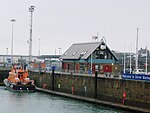Dover firebomb attack
2020s in Kent2022 in EnglandArson in EnglandArson in the 2020sAttacks in the United Kingdom in 2022 ... and 10 more
Attacks on buildings and structures in 2022Building bombings in EnglandCrime in KentDover, KentOctober 2022 crimes in EuropeOctober 2022 events in the United KingdomRight-wing terrorist incidentsTerrorist incidents in EnglandTerrorist incidents in the United Kingdom in 2022United Kingdom border control
On 30 October 2022, a petrol bomb attack was perpetrated against a Border Force centre for processing migrants in Dover, Kent, England. Two people suffered minor injuries. After the attack, the suspect, a 66-year-old man from High Wycombe, Buckinghamshire, drove to a nearby petrol station where he killed himself.
Excerpt from the Wikipedia article Dover firebomb attack (License: CC BY-SA 3.0, Authors).Dover firebomb attack
Lord Warden Square,
Geographical coordinates (GPS) Address Nearby Places Show on map
Geographical coordinates (GPS)
| Latitude | Longitude |
|---|---|
| N 51.1154 ° | E 1.31198 ° |
Address
Lord Warden Square
CT17 9EQ , Clarendon
England, United Kingdom
Open on Google Maps











